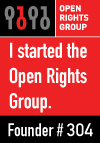Macrossan: New software patent case
Lawyer Simon Hart has sent me this very interesting email, and has allowed its reproduction:
I was involved in the recently decided Macrossan case [2006] EWHC 705 (Ch) before the High Court in England which I believe will be of interest to intellectual property lawyers and anyone who follows UK patent law. (A link to a report of the case is:
http://www.bailii.org/ew/cases/EWHC/Ch/2006/705.html )
The decision of Mr Justice Mann, handed down on 3rd April 2006, appears to have significant implications for software patenting in the UK. The case concerned the patentability of an automated method of producing the documents necessary to incorporate a company. The system has been deployed on the internet since May 2003 at www.ukcorporator.co.uk.
A Patent Office Hearing Officer had rejected the patent application in March 2005, relying on all three of the commonly raised exclusions in the context of software patents, namely, the mental act exclusion, the computer program exclusion and the business method exclusion. Mr Macrossan sought to counter all three exclusions and also raised an allegation of ‘apprehended bias’ against the Patent Office Hearing Officer. The bias allegation was based upon an alleged secret submission made to the Hearing Officer by the Patent Office examiner and was also based upon a Patent Office internet publication (still appearing at http://www.patent.gov.uk/about/ippd/issues/softpat.pdf ). The internet publication refers to the Patent Office’s “ … strong tradition of rejecting patent applications for software … “ and goes on to say that “… this tough approach has ensured that only patents with a ‘high presumption of validity’ are granted.”.
The Court ruled against Mr Macrossan on two of the three exclusions and also on the bias point. Interestingly however, the Court ruled in Mr Macrossan’s favour on the ‘business method’ exclusion point.
The Patent Office has, for years, been relying on the business method exclusion to assist it in denying all manner of patent applications, for example –But the Court in Macrossan’s case accepted Mr Macrossan’s argument that the business method exclusion does not apply to ‘partial methods’ of doing business. Mr Macrossan argued that the business method exclusion was directed to entire methods of doing business, such as a method of running a particular franchise business. He drew a parallel with the telephone, submitting that a telephone, assuming for the argument that it was a new invention, would hardly be excluded from patentability merely because it may be used in business. It is merely a ‘tool’ for use in business, rather than an entire business method. The Court accepted these arguments and ruled against the Patent Office on this point.
- a method for facilitating online payment transactions between participants in a network based transaction facility (eBay case BL O/314/04),
- an automated food ordering system for cafeterias (Fujitsu case Applic. No. 9912296.2),
- a web-based on-line user interface for enabling a customer to custom configure a computer system (Dell USA’s case),
- an automated reminder and actioning system for use in a patent attorney’s office (Venner case BL O/106/04), and
- an automated system for machine translation of a foreign language communication (Wordlingo case BL O/110/04).
The bias point has rarely, if ever, been considered previously in the context of a Patent Office Hearing and unfortunately the judgment only partly clarifies the law on this point. Mr Justice Mann at one point said “ … I do not consider that the full bias rule, as such, applies to a hearing of this nature.”. It is apparent from this remark that His Honour thought the rule has at least some application, but unfortunately His Honour did not elaborate. In the final analysis, the Court found that the rule against apprehended bias did not assist Mr Macrossan on the facts of the case. One is left wondering as to the precise scope of rule’s operation, as the case for apprehended bias in the Macrossan case seemed quite strong.

 del.icio.us
del.icio.us




No comments:
Post a Comment